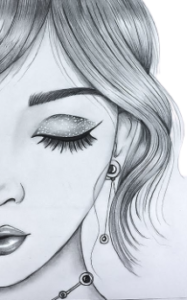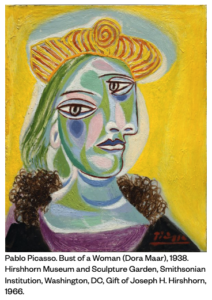What does the following image show:

Everyone who sees this simple sketch will recognize a human face. Of course, no face is a half oval—and all faces include vast more details than are shown here. But by providing a few lines, the illustrator gets the viewer to construct a whole portrait in her mind.
We also see a human with an image like this:

No human looks like this. But Picasso immediately enlists the viewer to think of it as a human. The distortions tell us something about the absurdity of modern life.
Storifying What’s Not There: Often we see something that’s not there because we think it should be there. In fact, this happens all the time. How is that so?
The reason is simple: People are narrative creatures. We make sense of the world by making stories of what we see. We project all kinds of ideas and meaning onto the world.
Consider the following picture, Isabel Chenoweth’s “Hanging Out.” The image shows a threesome of girls sitting on the hill overlooking one of the fields of the Little League World Series in 2005. As yourself: What’s happening in the picture?

As we examine the picture, we instantly make assumptions. We might notice that they are young teens. We might notice their different looks. We might notice a boy sitting nearby. Our eyes might move along the hill to see other fans or down to the field where a game is taking place. Or we might look in the stands—and if we do, we might notice the fans (families, mostly) of the two teams on the first and third base sides. If we know something about Williamsport, we might notice the trees in the distance—and we might know that the Susquehanna River lies beyond those trees.
Depending on our focus, we will see:
- Little League groupies or family members
- Teens eager to get out of the house and be with friends
- Boys trying to flirt with girls
- Pre-teen boys playing games in front of millions of people
- Families getting carried away in the frenzy of an international tournament, broadcast on TV all over the world
- The rise and fall of a once-prosperous lumber town
Wherever we focus, we are likely to construct a story. If we assume the girls are fans—maybe sisters of players—we will construct one story. But they don’t seem to be watching the game. Maybe they’re just hanging out.
Whatever we assume about what we’re watching, we are putting something in the picture that’s not there. We are focusing on some parts of the picture and ignoring others.
Here’s a starker example of seeing what’s not in the picture. Watch this video and figure out what you think the videographer is trying to tell the audience.
Over the years, we have shown this video to thousands of students. Under some of the most common interpretations, this video shows:
- The power over the government in Nazi Germany
- The cruel dominance of “popular” cliques in a high school.
- A struggle between parents and their adolescent children
- Competition between businesses for a lucrative market.
In fact, the video simply shows the movement of two-dimensional shapes—no more and no less. But because people constantly construct stories out of the scantest evidence, virtually no one who sees this video sees it for what it is.
The creators of the Video, Fritz Haider and Maryanne Simmel, created the video to show how anthropocentric people are. That is: We see humans in just about everything we see.
Looking Forward
- Seeing for Future-Oriented Leadership
- Exercise: Plato’s Allegory of the Cave
- Seeing: Starting with Saccades
- Seeing What is There
- Seeing What’s Not There
- Seeing What’s Not There: Cases in Point (you are here)
- Not Seeing What’s There
- Not Seeing What’s Not There
- Stillness and Motion
- Making Seeing a Superpower
- A Whole Strategy for Seeing, Thinking, and Leading
- Videos on Seeing for Leadership
